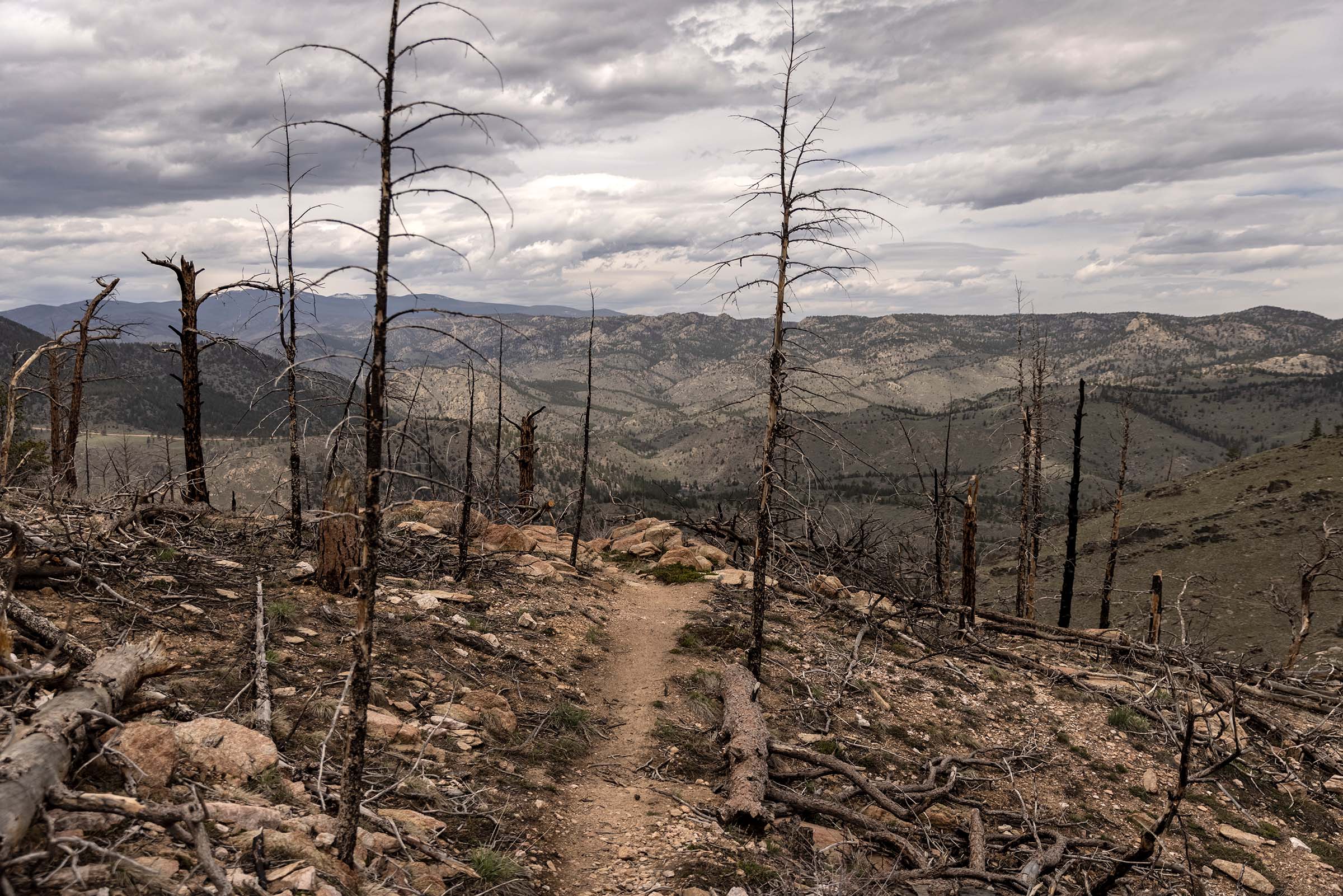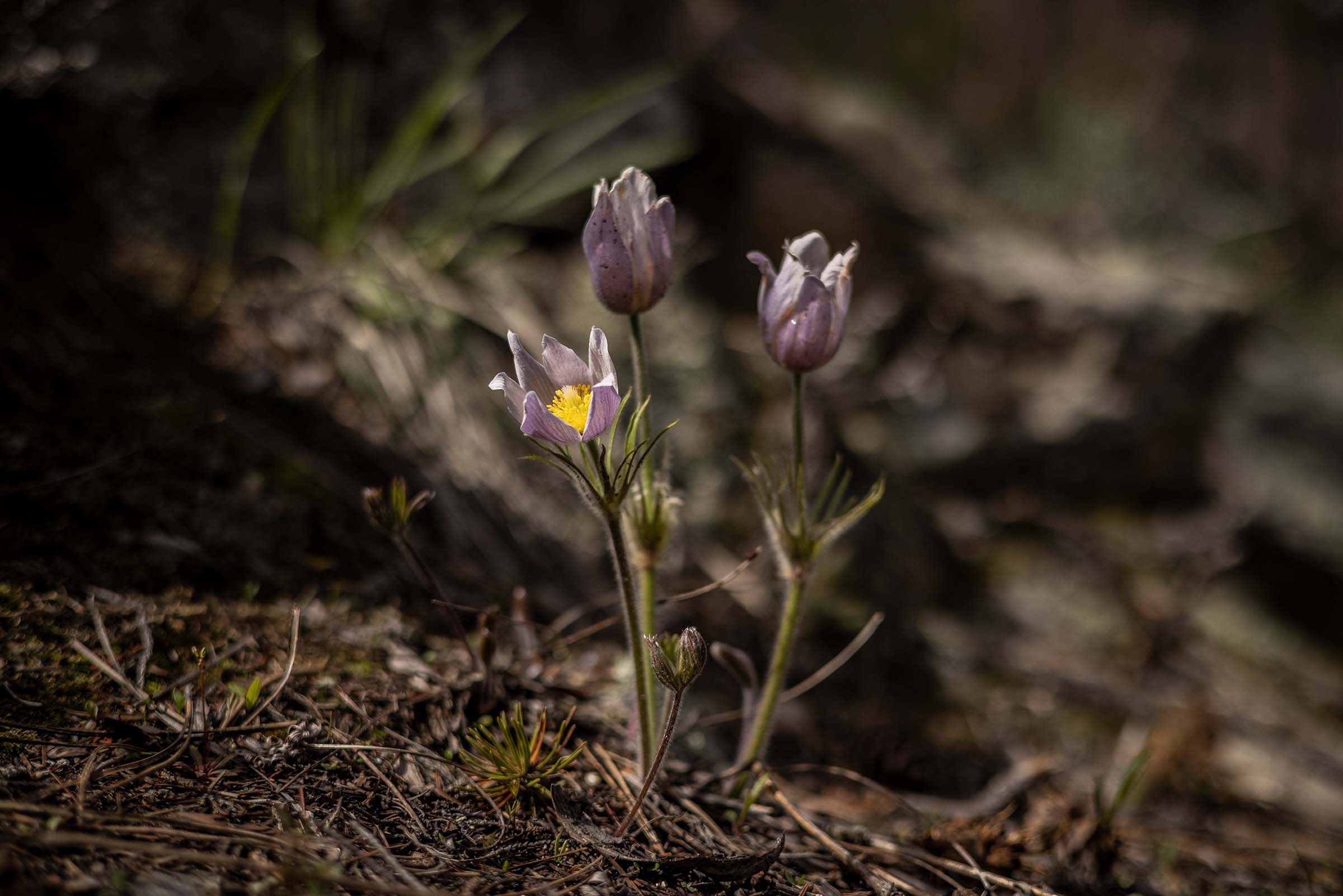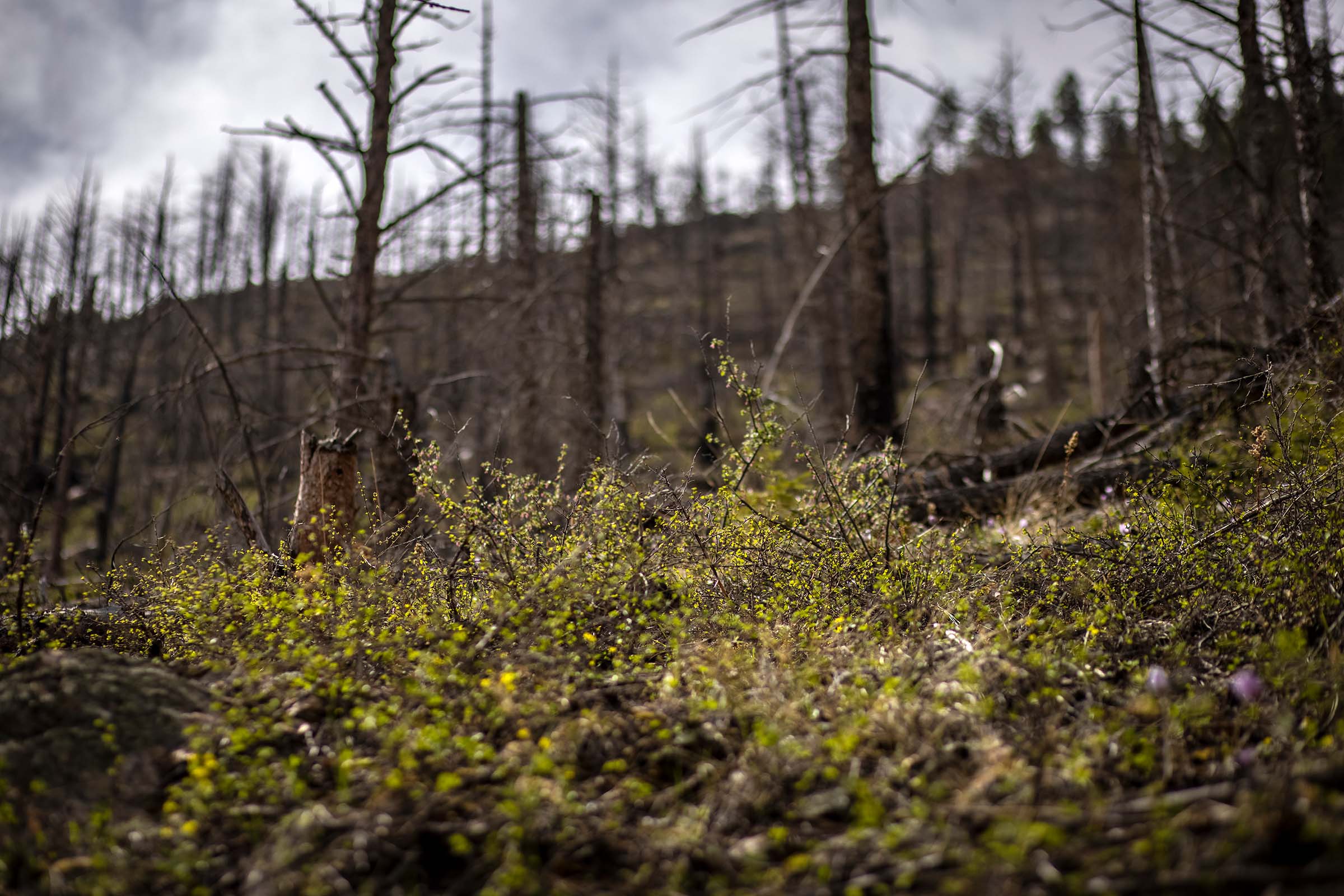Colorado's Fire Seasons Are Worse Than Ever. But There's Reason for Hope.

(Photo: Diana Ejaita)
We were standing on the trail that ascends 8,012-foot Mt. McConnel, just west of Fort Collins, Colorado. The peak was torched in the High Park fire back in 2012; you might think that, almost a decade later, ponderosa pines would be reclaiming their turf. But no. Scorched trees stood at attention right up to the horizon, like the honor guard for a funeral. Cause of death: climate change.
And yet, Camille Stevens-Rumann, Ph.D., assistant professor of forest and rangeland stewardship at Colorado State University, was smiling. She was looking down at her feet, where a fuzzy little pasque flower was pushing up through the forest litter. Two native bufflehead mason bees spelunked for nectar inside the blossom. The name “pasque” sounds like the French word for Easter, which is about when this purple wildflower emerges from the earth. I saw it as an apt sign that resurrection is possible, even on this blackened mountainside.
Last summer, record-breaking wildfires tore through Colorado, torching 625,000 acres of forest. The East Troublesome fire, 50 miles from my house in Fort Collins, erupted from 18,550 to 187,964 acres in three days last October, turning the skies orange, rendering the sun a bloodshot eyeball, and plunging air quality into the hold-your-breath range. In the same incendiary season, the Cameron Peak fire, just to the north of East Troublesome, and the Pine Gulch fire, on the Western Slope, roared to the top of the list of Colorado’s largest-ever wildfires.
But even before the smoke cleared, I felt some hope.

Just after my wife and I moved to Colorado in 2017, our niece Kellie came out on a college reconnaissance trip. I suggested a hike up Mt. McConnel in Poudre Canyon, west of Fort Collins. We walked a stretch of trail through fragrant ponderosas and Douglas fir by the river, then marched uphill into a forest graveyard. But it wasn’t all scorched earth: A summer show of Indian paintbrush, bluebell, elephant’s head, and blanket flower covered the otherwise bare mountain flanks. It reminded me that nature is an opportunist. When trees go, other species get a chance.
Living through the hell of Rocky Mountain fires in 2020, I thought of those wildflowers. A tree’s death opens a life-giving patch of sunlight on the forest floor, and a fallen trunk provides a habitat for small creatures and returns nutrients to the soil. Fire is also a tool for some trees: The southern shortleaf pine and the California buckeye sprout from their roots when fire kills the crown. Colorado’s lodgepoles are serotinous pines, meaning they have waxy cones that only release their seeds after extreme heat.
Through friends in Fort Collins, I met Dr. Stevens-Rumann. She majored in environmental studies at Brandeis and earned her Ph.D. in natural resources from the University of Idaho. She busted out of the classroom for a stint as a hotshot firefighter, battling blazes in New Mexico and South Dakota. After she completed her Ph.D., she joined researchers documenting the post-fire recovery in Yellowstone. She knows how nature giveth, and how it taketh away. In the wake of the 2020 fires, I needed perspective on what happened, and where we were headed. So I invited her out to Mt. McConnel for a damage assessment and wildflower inventory.
Throughout our hike, she and I seemed to notice different aspects of the same charred landscape. For me, it was a brutal game of pick-up sticks, with lodgepole trunks scattered across a steep slope. For her: nature working its patient progress.
At one point, we looked into a funnel-shaped declivity where the wind-driven blast furnace must have raged during the height of the blaze. Fires run uphill, heating the air and the fuel as they go. And go they do, until the hot air reaches a ridgetop, at which point it flies up into the atmosphere, sometimes sparing the trees just over the crest.

Colorado had seen large fires before last year. The High Park fire was started by a lightning strike on June 9, 2012. It burned over 87,000 acres, destroyed 259 homes, and claimed one human life before it was extinguished 21 days later. The U.S. Forest Service noted that half the burn was of moderate or high severity, which means more runoff and slower regeneration. The following year, devastating floods destroyed roads and polluted major water sources for nearby communities. At that time, High Park was the second-biggest fire in Colorado history. A decade later, it’s the seventh.
As we explored the burn zone, Stevens-Rumann pointed out a line of green along the ridge 500 vertical feet above us. “Those trees have been dropping cones ever since the fire,” she said, gesturing at their offspring: a dozen baby lodgepoles peeking up through the chaos. “This really looks hopeful to me,” she continued. “Think how many full-grown trees were in this space before the fire. These sprigs will reestablish the canopy.”
She knelt next to a pipsqueak pine and counted five paired branches, which meant five years of growth since it had sprouted. Small hope indeed, but hope nonetheless. We could see tufts of grass, outcroppings of greening sage, and a lone mullein spike, still brown from last season. These plants and a host of others will bloom again this summer, attracting native bees and visiting hikers.
Stevens-Rumann’s favorite post-fire plant is actually a fungus. “In the year after a fire, morel mushrooms pop up everywhere.” They look like brains, she says, but if you’re not sure, leave them be. A “false morel” might be your last supper.

“I’m so excited about tree regeneration here,” Stevens-Rumman said as we continued through the burn scar. “There are a lot of seedlings. It will take at least 50 years to regrow, though.” Last summer, a University of Colorado Boulder study projected that, by 2050, only 18 percent of these formerly majestic forests will recover, even with the rosiest climate projections. I’ll be long dead by the time these seedlings are shade trees. So now, post-inferno, it’s time to take a different kind of long view of the mountains. Stevens-Rumman has two sons, as do I. Our grandkids may walk among ponderosas and lodgepoles here in 2070, if we do the necessary climate work right now.
What kind of work? Colorado released a “greenhouse gas reduction roadmap” after the flames were snuffed out last year, proposing steps such as pivoting from coal-generated power toward renewables, and reducing methane production from oil and gas development and from wastewater. The state is also pursuing nature-based climate solutions including preserving the state’s grasslands, which are a potent carbon sink and extract polluting CO₂ from the air. Replanting pines will help, too. In the meantime, the Forest Service will be aiming aircraft-borne mulch cannons at the scorched earth to protect and stabilize vulnerable soil.
A study by the Nature Conservancy showed that such natural measures can help provide more than a third of the reductions needed to limit global temperature rise to less than 2°C—the globally-accepted cap for temperature increase to prevent catastrophic changes to the planet. Combined with worldwide efforts to increase carbon sequestration and controlled burns to limit fuel in vulnerable forests, it could help tame the flames.
But even if these measures succeed, we may be looking at permanent change on these mountainsides. A study published last summer in Global Ecology and Biogeography predicts a transition from forests to grasslands as a warming climate raises temperatures in the burn scars. Scientists from the University of Colorado Boulder looked at burn zones eight to 15 years after past wildfires. Eighty percent of these zones had little or no regrowth of saplings because of increased temperatures and low moisture. But as Stevens-Rumann told NPR last year: “It’s not a goodbye to the trees, it’s ‘see you later, uphill.’” That is, as grasslands fill in at lower altitudes, trees will migrate upslope in search of cooler temperatures and more precipitation. These new ecosystems may look different from our beloved forests, but they represent nature’s adaptability.
Our hike ended when we reached a grassy, windswept shoulder on Mt. McConnel, with westward views toward Rocky Mountain National Park. The high peaks were crowned with spiky tree trunks; I asked Stevens-Rumann if they were off-season aspen. No such luck.
“That’s the aftermath of the Cameron Peak fire,” Stevens-Rumann said. “Interestingly, though, when that fire hit the burn scars from High Park, it stopped. There wasn’t enough fuel to keep it going.”
That’s the dire place we’re in right now: Cataclysmic burns are frequent enough that when next year’s reaches the boundaries of this year’s, it’ll fizzle because there’s nothing left to burn. But is that really grounds for optimism? It’s like a war that ends because all the combatants have been killed.
Still, even as that war rages in the trees, and in legislative chambers around the world, there’s still hope to be found, if we know where to look. The wildflowers on Mt. McConnel are thriving in the sunlight. Change begins at the root level, and it can be beautiful.